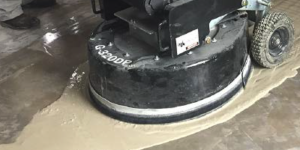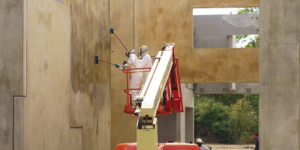There has been quite the dust-up (pardon the pun) about the U.S. Occupational Safety and Health Administration new respirable crystalline silica regulations impacting the construction industry. It has been front and center at industry trade shows, in newsletters and educational seminars over the last six months. OSHA recently delayed the enforcement of the new regulations until Sept. 23, 2017, because of the number of questions and level of confusion on how to implement the new regulations.
The new regulations comprise two standards: one for construction and one for general industry and maritime. The decorative concrete industry is a very small segment of the construction industry, but it will fall under the new regulations just the same.
The polished concrete segment of our industry appears to be the primary focus of the new regulations because of the amount of concrete dust consistently produced over long periods of time. What I find interesting is that these same new regulations are impacting color hardener and release powder even though they are considered low exposure products.
Dust basics
Full disclosure: I work for ChemSystems Inc., a manufacturer of color hardener, release powder and decorative overlay products. This article is about clearing the air (sorry, these puns are just too easy) when it comes to the impact of the new regulations on these other industries, as well as for educational purposes.
I’ve recently been privy to many conversations regarding the new regulations and how they’re interpreted by installers, municipalities and government agencies, specifiers and manufacturers. Comments include “we can’t use color hardener anymore because of the silica content listed on the Safety Data Sheets” or “release powder will cause lung cancer” or “I have to get out of the overlay business because we produce too much dangerous dust when we break bags.”
These statements threaten our industry, are generated from ignorance and/or hysteria and, in most cases, are blatantly false.
Before I address why these products aren’t as bad as made out to be, let’s first clarify a few things.
Safety is, and should always be, the top priority on any job site.
“It’s considered that dusts are solid particles, ranging in size from below 1 µm (a unit of length equal to one millionth of a meter) up to at least 100 µm, which may be or become airborne, depending on their origin, physical characteristics and ambient conditions.”
Not all dust is dangerous in regard to long-term health. In fact, most dust is considered inert. The human body has an amazing cleaning and filtering system for trapping airborne dust as it enters the body.
Dust of certain materials, when inhaled long term, can be considered detrimental to humans. It’s the cumulative effect of dust over time that has the negative impact on your health.
The construction standard doesn’t apply where exposures will remain low under any foreseeable conditions, such as when performing tasks like mixing mortar. This applies to color hardener, release powder and cement-based overlays when used in an exterior setting under most conditions. It’s always good practice to protect against dust so a good quality HEPA (High Efficiency Particulate Air) dust mask is always recommended.
Make up and exposure
I’ve come up with a name for products in the decorative industry that produce dust by their physical makeup and/or application: “passive dust-producing” products, with the big three being color hardener, release powder and cement-based decorative overlays.
All these are powders that produce dust when handled and/or installed per manufacturers’ guidelines. What they don’t have in common with the key industries the OSHA regulations are targeting (grinding, dry polishing and cutting cement-based products) is that they don’t all contain respirable crystalline silica. Those that do contain very small amounts that often never reach the point of being inhaled.
This means that exposure is limited and, in some cases, is not a factor at all. The OSHA document states, “The construction standard does not apply where exposures will remain low under any foreseeable conditions,” which I think is vague and unclear.
Color hardener – Each manufacturer has its own proprietary formula, but in general the ingredients are 70 to 80 percent silica sand, 10 to 20 percent portland cement, 3 to 10 percent pigments, and 1 to 5 percent other fillers and chemicals. Portland cement is considered a dust producer, but its main health effect is dermatosis, or damage to the skin.
Although silica sand does contain respirable crystalline silica, it’s contained in the sand grain. Even the smallest size sand used in color hardener is larger than the 100 µm size established as the maximum for a dust. This means that color hardener, while containing a large volume of silica sand, is not producing much respirable crystalline silica because the particles are too large to be inhaled. Of course, there will always be a small amount of dust produced from friction and breakdown, but according to multiple SDS researched, the amount ranges from >0.1 percent to <1 percent by weight.
The last major ingredient is the pigment. Most all pigments used in color hardener are metal-based oxides (iron, cobalt, chrome) and contain no respirable crystalline silica. It’s important to also note that when color hardener is applied by hand, it’s thrown away from the body, which will minimize inhalation.
Release powder – Generally it’s composed of 90 to 97 percent calcium carbonate and/or calcium stearate, and 3 to 10 percent pigment, all of which have zero respirable crystalline silica. Calcium carbonate and calcium stearate are used in many foods and pharmaceuticals as inert fillers. Release powder doesn’t contain any respirable crystalline silica.
Decorative overlays – The ingredients can vary widely depending on product and manufacturer, but once again most are 10 to 30 percent portland cement, 60 to 70 percent silica sand, and the remaining ingredients are fillers and supporting chemicals, most of which aren’t respiratory crystalline silica producers. Consult the SDS of the product you’re using for full details.
Why the hysterics
In my research, I couldn’t find one government agency, city, municipality or county that has a written policy prohibiting the use of color hardener, release powder or other decorative passive dust-producing materials, yet I hear more and more about these products being prohibited from use for dust control and/or silica exposure. If you know of an official written policy, please email me!
The negative rap associated with color hardener, release powder and, to a lesser extent, decorative overlays is due to the fact that they’re dirty. The images of installers covered from head to toe with color, or the horror stories of covering the neighbor’s car with color on a windy day, don’t help the cause. Colored runoff going down the drain in a neighborhood is another common complaint, especially in today’s hypersensitive and environmentally conscious world.
Rich Cofoid Sr., product manager for Increte, is familiar with these issues and how perception and regulations can impact our industry, even when the reality is vastly different. “If precautions are taken to limit runoff and keep it out of pools, ponds, streams, etc., then there usually isn’t a problem,” he says. “The use of straw buoys to capture the release before it enters a storm drain (actually before it enters the curb or street, as staining of the street is usually when a contractor starts getting nasty calls) is all it takes.”
I can’t argue that these products can be dirty, but there is a difference between dirty and dangerous. I’ve also seen companies with good housekeeping practices that can mix and apply these products without getting it all over themselves and/or the surrounding buildings and landscaping.
I think, and many in the industry agree, that color hardener and release powder produce the best-looking colors and most realistic surface when stamping concrete. It would be a significant loss if they were falsely regulated.
Do your own homework
“The new OSHA standard requires employers to limit worker exposure to respirable crystalline silica and to take other steps to protect workers.” The new standard isn’t intended to brand certain products as environmentally unfriendly, especially when the new regulations don’t apply.
I encourage everyone to do their own research and not fall victim to industry rumor, gossip or unfounded hysterics. Educate yourself on what is and what isn’t a respiratory crystalline silica producer, and follow the guidelines that pertain.
Safety is important, but overreach and nonspecific regulations can have an adverse effect. As Cofoid says, “If left unchecked and unanswered, many good products will end up with bad PR or, worse yet, become illegal and/or highly regulated.”
To view an OSHA fact sheet on its crystalline silica rule in construction, visit www.osha.gov/Publications/OSHA3681.pdf
















